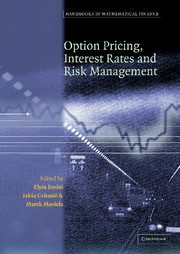Book contents
- Frontmatter
- Contents
- List of Contributors
- Introduction
- Part one Option Pricing: Theory and Practice
- Part two Interest Rate Modeling
- Part three Risk Management and Hedging
- 11 Credit Risk Modelling: Intensity Based Approach
- 12 Towards a Theory of Volatility Trading
- 13 Shortfall Risk in Long-Term Hedging with Short-Term Futures Contracts
- 14 Numerical Comparison of Local Risk-Minimisation and Mean-Variance Hedging
- 15 A Guided Tour through Quadratic Hedging Approaches
- Part four Utility Maximization
11 - Credit Risk Modelling: Intensity Based Approach
from Part three - Risk Management and Hedging
Published online by Cambridge University Press: 29 January 2010
- Frontmatter
- Contents
- List of Contributors
- Introduction
- Part one Option Pricing: Theory and Practice
- Part two Interest Rate Modeling
- Part three Risk Management and Hedging
- 11 Credit Risk Modelling: Intensity Based Approach
- 12 Towards a Theory of Volatility Trading
- 13 Shortfall Risk in Long-Term Hedging with Short-Term Futures Contracts
- 14 Numerical Comparison of Local Risk-Minimisation and Mean-Variance Hedging
- 15 A Guided Tour through Quadratic Hedging Approaches
- Part four Utility Maximization
Summary
Introduction
Let B(t, T) and D(t, T) denote prices at time t of default-free and default-risky (or defaultable) zero coupon bonds maturing at time T, respectively. The default -free bond pays $1 at time T. The (recovery) payment for the default-risky bond needs to be modelled. Two major situations are commonly considered (if the bond defaults prior to or on the maturity date then): (a) the recovery payment is received by the holder of the defaultable bond at the default time of the bond, or (b) the recovery payment is received by the holder of the defaultable bond at the maturity time of the bond. Of course, if the defaultable bond does not default prior to or on the maturity date, then it pays $1 at maturity.
In this chapter we present a survey of recent research efforts aimed at pricing and hedging of default -prone debt instruments. We concentrate on intensity and ratings based approaches. In particular we review some results derived by Duffie, Schröder and Skiadas (1996), Duffie and Singleton (1998a, 1999), Jarrow and Turnbull (1995, 2000), Jarrow, Lando and Turnbull (1997), Lando (1998), Madan and Unal (1998a, 1998b), Jeanblanc and Rutkowski (2000a, 2000b), Bielecki and Rutkowski (1999, 2000), and Lotz and Schlögl (2000), among results obtained by other researchers. In addition we present a brief survey of some important types of credit derivatives, that is derivative products linked to either corporate or sovereign debt, and we describe how to price them within the Bielecki and Rutkowski approach.
- Type
- Chapter
- Information
- Handbooks in Mathematical FinanceOption Pricing, Interest Rates and Risk Management, pp. 399 - 457Publisher: Cambridge University PressPrint publication year: 2001
- 3
- Cited by

